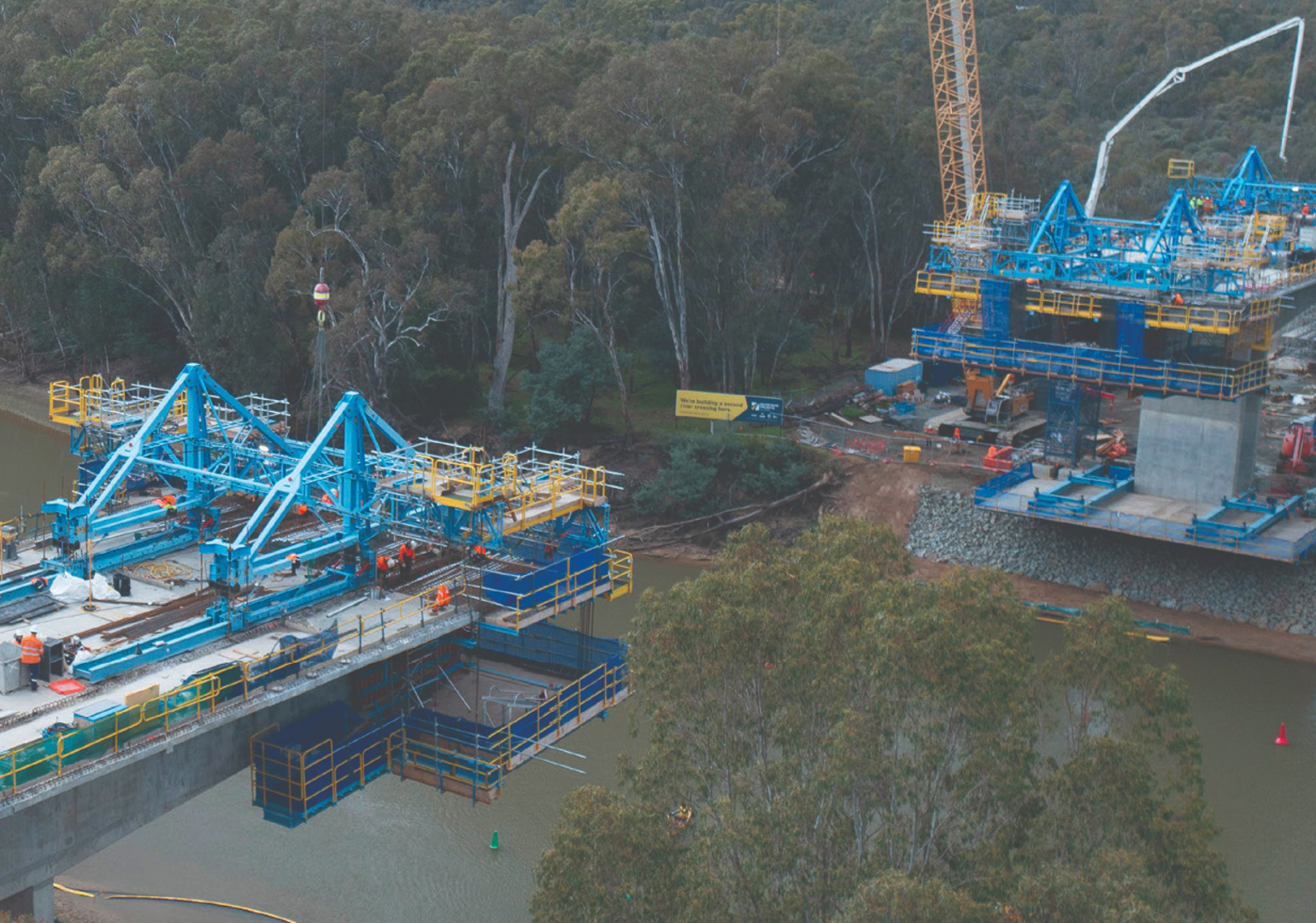A long-awaited Murray River crossing on the New South Wales–Victoria border built in challenging circumstances has transformed one regional community.
Unless they’re discussing sporting rivalries, Australians do not spend a lot of time thinking about the state jurisdictions delineating the nation. For the great majority of the population, those borders are little more than lines on a map.
Of the many disorienting and disruptive responses to the COVID-19 pandemic during 2020 and 2021, the transformation of these lines overnight into hard and near-impenetrable borders underscored how unusual the times were for the country.
Amid this interstate fragmentation, however, one team of engineers was tasked with bringing two states closer together, constructing two bridges over the Campaspe and Murray rivers and linking the towns of Echuca and Moama on the Victoria–New South Wales border.
“We were the only job that was delivering across the border in Australia,” recalled Matt Boyd, the McConnell Dowell project director who oversaw construction of the bridges.
“It was quite a challenging time to get a workforce, and then actually try to deliver a project when movements were heavily restricted.”
And yet, Boyd notes proudly, at no point did the team have to stop work.
“There was a period there for about two weeks where they actually shut down every construction site in Melbourne, but we didn’t shut down and at that point in time, we were probably the largest project [in the state] still running,” Boyd said.
“The team was able to adapt and find ways to work through every barrier that was put up in front of us and find a solution to overcome it – and then continue to deliver.”
As a result, in April 2022, the $324 million project was delivered under budget and ahead of schedule, an achievement that contributed to it being selected as a finalist in the 2023 Australian Construction Achievement Award.
Years in the making
Until now, the two towns – Echuca in Victoria and Moama in New South Wales – were linked by a single bridge across the Murray River that opened in 1878. The closest alternative crossing involved a round trip of more than 100 km.
According to Major Roads Projects Victoria’s Damian Van Dyke, the new crossing removed 10,000 vehicles from existing roads and now caters for agricultural and larger freight vehicles.
Boyd described the second crossing as “definitely well needed”.
“The existing crossing is an old structure that has been a bottleneck for many years,” he said. “The new structure and road takes half the traffic – and particularly the heavy vehicle traffic – out of the townships of Echuca–Moama, so you’re drastically improving the flow through both.”

A critical requirement for the Murray River crossing – and one that proved a significant challenge for the McConnell Dowell team – was to construct the bridge without building piers in the water.
And although that permitted the team to keep the river open to boat traffic throughout the build, its primary concern was the project’s ecological impact. The design they used was a 115 m in-situ balanced cantilevered span.
The method is an uncommon one in Australia, Boyd said.
“Often they’re done with precast segments, but due to the location of the works it was done as an in-situ concrete pour: a series of travelling formwork that was moved out per segment, and then poured in place.”
A McConnell Dowell technical paper described this process as taking place over a five to seven-day cycle.
“The first stage required the reinforcement to be positioned for the 5 m segment, followed by concrete placement and curing,” the paper said. “The cables were then tensioned and the traveller form machine moved to the next segment.”
The pandemic-imposed restrictions on either side of the border greatly increased the complexity of this aspect of the construction.
Some contractors proved unable to provide a full workforce, requiring McConnell Dowell to reduce its reliance on some and draw on alternative contractors.
“We had a specialist contractor that was meant to do the balanced cantilever with a crew that would literally go between Victoria and New South Wales,” Boyd said.
“As a result [of the pandemic] they needed to be two completely separate crews.”
Community consultation
The bridges were built on traditional Yorta Yorta lands, and it was important to the team to partner with Indigenous communities in delivering the project.
The workforce consisted, at its peak, of 7.3 per cent First Nations people and it spent $3.46 million with Aboriginal-owned businesses.
“A lot of employment and contractors were not just Indigenous, but local Indigenous,” Boyd said. “Which helped the consultation with the wider community, because we were actually using people from the community in the delivery of the project.
“We were able to avoid some pretty sensitive areas through the build, and particularly through the temporary staging, which definitely helped the relationship.”
McConnell Dowell also engaged with Vivid, a regionally based not-for-profit organisation that helps people with disability find work.
Twenty people from Vivid were engaged in maintenance, cleaning and landscaping work during the build, as well as formal training that went on to lead to other employment opportunities.
The project was welcomed by the entire community, Boyd said.
“I’ve never been on a project where the community’s embraced a project like they did with us – probably helped by the fact that it was due to be completed in about 1970,” he explained.
In fact, the towns had begun campaigning for a second Murray crossing in 1965.
“It’s 18 months after we opened this project, and people still talk about how much better it’s made the town,” Boyd said. “And how we behaved when we were in town – which for a rural regional project is extremely important … People remember you a lot more in a regional town than they do in the city.
“You don’t often get a second chance in a regional town.”